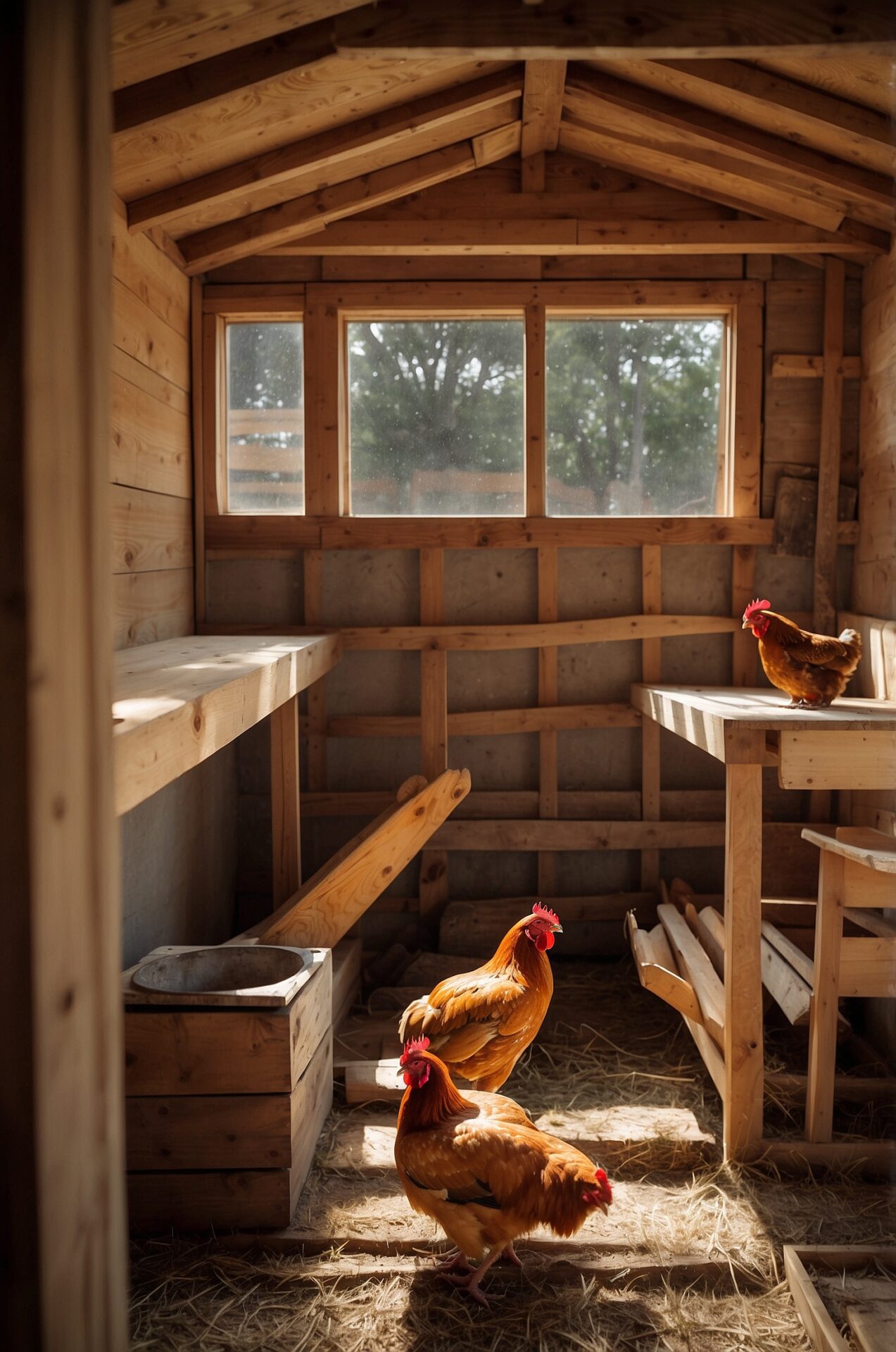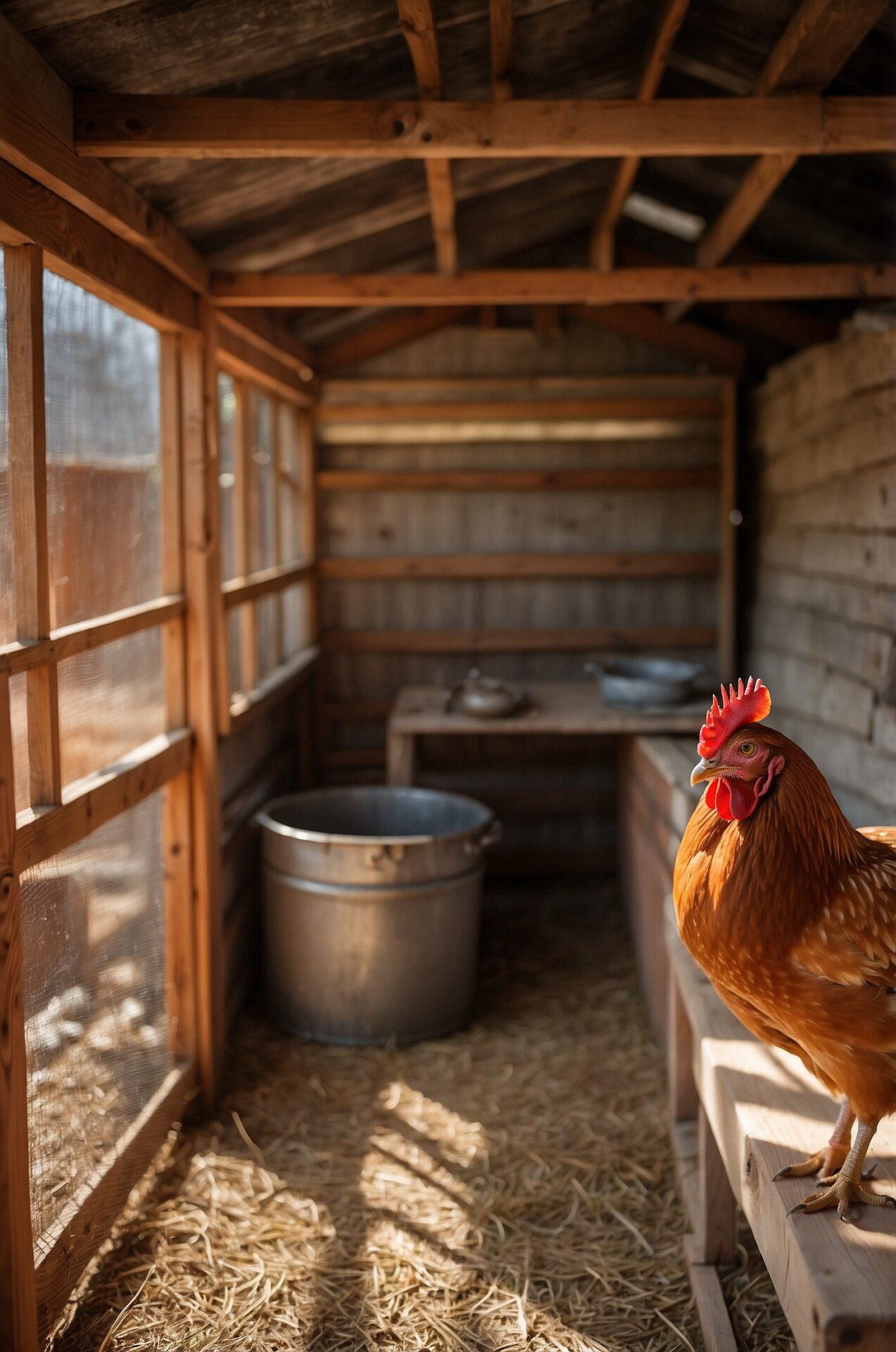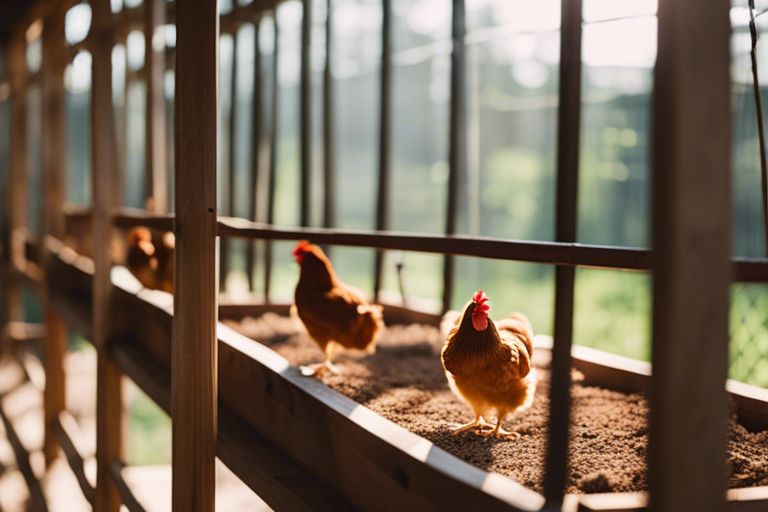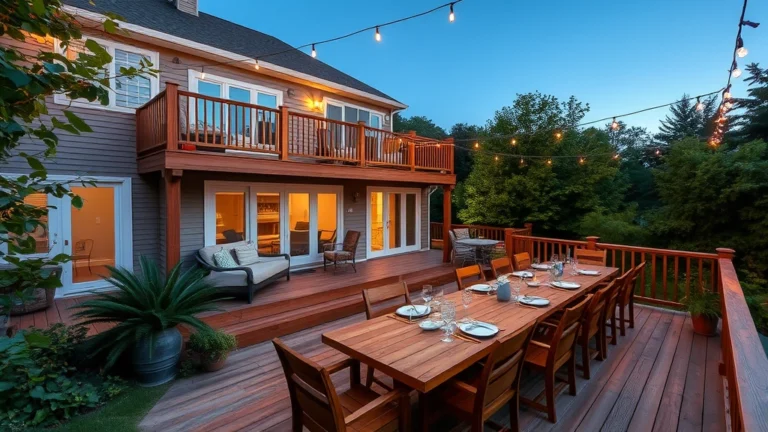32 Inside Chicken Coop Designs

Over the years, I’ve discovered that the key to happy and healthy chickens is a well-designed coop.
In this post, I’ll share 32 stunning inside chicken coop designs that will inspire you to create a cozy and functional space for your feathered friends.
Whether you’re looking for ideas to maximize space, improve ventilation, or enhance the overall aesthetics of your coop, I’ve got you covered with a wide range of options to suit your needs.
Essential Elements of a Chicken Coop

Ventilation and Air Quality
The ventilation in your chicken coop is crucial to the health and well-being of your feathered friends. Air quality is important in preventing respiratory issues and the buildup of harmful ammonia fumes from droppings. Ensure your coop has adequate ventilation, such as windows, vents, or openings near the roof, to allow fresh air to circulate.
Lighting and Electrical Considerations

Essential lighting can help regulate the hens’ egg-laying cycle, especially during the darker winter months. Consider installing a timer to control the lights, providing around 14-16 hours of light per day to keep your hens productive. Additionally, electrical outlets may be necessary for heat lamps in the winter or automatic door openers for convenience.
Considerations such as fire safety are crucial when adding electrical elements to your coop. Always use insulated wiring and keep all electrical components out of reach of curious beaks. Regularly inspect and maintain all lighting and electrical features to prevent any hazards in your coop.
Coop Size and Layout

Small Coops for Backyard Flocks
Any successful chicken keeping venture starts with the right coop size and layout. To ensure the comfort and well-being of your feathered friends, small coops for backyard flocks should provide at least 2 square feet of space per bird. This allows ample room for the chickens to move around, roost, and nest comfortably.
Large Coops for Extended Flocks

Backyard coops can quickly become overcrowded, leading to stress, aggression, and decreased egg production. That’s why if you’re considering expanding your flock, another option is to opt for large coops suitable for extended flocks. These spacious setups offer more than 4 square feet per bird, ensuring they have plenty of space to roam, forage, and establish a pecking order.
Large coops for extended flocks also provide room for adding new members to the flock without causing overcrowding issues. Proper ventilation and multiple nesting boxes can further enhance the coop’s functionality for larger groups of chickens.
Coop Shapes and Configurations
To maximize space and efficiency, consider different coop shapes and configurations that suit your flock size and space constraints. Whether you prefer a traditional rectangular coop or a more unique A-frame design, each shape offers its own advantages in terms of ventilation, cleaning, and access for you and your chickens.
Extended runs attached to the coop can provide additional space for your flock to graze and stretch their wings. By incorporating features like removable panels for easy cleaning and adjustable roosting bars, you can customize the coop to meet the specific needs of your chickens while making maintenance tasks more manageable.

Comfort and Convenience Features

Despite the practical purpose of a chicken coop, it’s important to ensure that your feathered friends are comfortable and have all the convenience features they need for a happy, healthy life.
Perches and Roosting Bars
Bars: Chickens love to perch and roost, so it’s crucial to have plenty of sturdy perches and roosting bars inside the coop. Make sure they are positioned higher than the nesting boxes to encourage your flock to sleep there at night.
Nesting Boxes and Egg Collection
Roosting: Nesting boxes should be cozy, private spaces where your hens can lay their eggs comfortably. Make sure they are easily accessible for egg collection, preferably from outside the coop to avoid disturbing the hens.
Collection: Regular egg collection is crucial to prevent eggs from being pecked or soiled. Check the nesting boxes at least once a day to gather fresh eggs and keep your coop clean.
Feeders and Watering Systems
Features: Invest in feeders and watering systems that are easy to refill and clean. Automatic feeders and waterers can save you time and ensure that your chickens always have access to fresh food and water.
Boxes: Place the feeders and waterers at a comfortable height for your chickens to reach without much effort. Consider elevated platforms or hanging options to prevent them from getting knocked over or contaminated with bedding.
Easy Cleaning and Maintenance
Any: To keep your coop clean and odor-free, incorporate features that make cleaning and maintenance a breeze. Removable litter trays, sliding droppings boards, and well-ventilated designs can help you easily keep the coop tidy.
Comfort: Providing your chickens with a clean, comfortable living space will not only benefit their health but also make your life as a chicken keeper much more enjoyable. With these comfort and convenience features in place, you can create a coop that both you and your feathered friends will love.
Predator Protection and Safety

Securing the Coop from Predators
All chicken owners know the importance of safeguarding their flock from potential predators. Securing the coop from these threats is crucial to the well-being of your chickens. Make sure to install sturdy hardware cloth on all openings to keep out predators like raccoons, foxes, and snakes. Adding a predator apron around the perimeter of the coop can also prevent digging animals from gaining access.
Locks and Latches for Secure Entry
In the context of predator protection, the devil is in the details. Latches and locks are your first line of defense against crafty predators that can figure out how to open simple latches. Invest in heavy-duty locks that are predator-proof, such as carabiner clips, padlocks, or even combination locks. These extra measures can give you peace of mind that your feathered friends are safe and secure.
Latches play a crucial role in keeping predators out of your chicken coop. Opt for self-locking latches that snap shut automatically, ensuring predators can’t jimmy the door open. Having multiple locks on different parts of the coop can also deter persistent predators from gaining access.
Fencing and Enclosure Options
Securing your chicken coop with proper fencing and enclosure options is crucial for their safety. Choose strong, durable fencing that is buried at least a foot underground to prevent predators from digging their way in. Consider adding a roof or netting over the enclosure to protect against aerial threats like hawks and owls.
Enclosure design should also take into account the size of the flock and their need for space to roam. A spacious outdoor run can provide exercise and enrichment for your chickens while keeping them safe from potential predators. Regularly inspect the fencing for any signs of wear or damage to ensure ongoing protection for your flock.

Climate Control and Insulation

Insulating the Coop for Cold Climates
Unlike warm climates, where keeping the coop cool is a priority, **insulating** your chicken coop is crucial for cold climates. Proper insulation will help **keep your coop warm** and cozy for your feathered friends during the chilly months. You can use materials like **foam boards, straw, or even recycled denim** to insulate the walls and roof of the coop.
Cooling the Coop for Warm Climates
Unlike cold climates, where insulation is key, **cooling** your chicken coop is important for warm climates. **Ensuring proper ventilation** is crucial to prevent your chickens from overheating. You can install **windows, vents, or fans** to promote air circulation and keep the coop comfortable.
**Cold temperatures can be just as dangerous for chickens as extreme heat.** If your coop gets too hot, your chickens can suffer from heat stress, leading to decreased egg production and even death. Be sure to monitor the temperature inside the coop regularly, especially during heatwaves, and provide **cooling options** if needed.
Managing Moisture and Humidity
Moisture control is important in any climate to **prevent mold, mildew, and respiratory issues** in your flock. Proper ventilation, **good drainage**, and using **absorbent bedding** like pine shavings can help manage moisture levels inside the coop.
In **varied climates**, the fluctuating temperatures and humidity levels can pose a challenge. Be proactive in addressing **moisture control** to create a healthy environment for your chickens year-round.

Aesthetics and Customization

Coop Colors and Exterior Finishes
One of the most exciting aspects of designing your chicken coop is choosing the colors and exterior finishes. Your chicken coop doesn’t have to be just functional; it can also be a beautiful addition to your yard. Consider using bold colors that complement your home’s exterior or opt for a more natural finish that blends seamlessly into the landscape.
Decorative Elements and Accessories
One fun way to personalize your chicken coop is by adding decorative elements and accessories. Think about incorporating hand-painted signs, weather vane, or even some floral arrangements around the coop. These small touches can make your coop feel more like a cozy retreat for your feathered friends.
It’s always important to consider the functionality of these decorative elements. You want to make sure they don’t impede your ability to clean or access the coop easily. Stick to accessories that can withstand the outdoor elements and are easy to maintain.
Integrating the Coop into Your Yard
To seamlessly integrate your chicken coop into your yard, consider the overall aesthetics and landscaping. Position the coop in an area that is easily accessible for you but also offers your chickens plenty of shade and protection from the elements. Surround the coop with lush greenery and maybe a small white picket fence to create a charming and cohesive look.
Your chicken coop should feel like a natural extension of your home and garden. By paying attention to the details and customizing the coop to fit your style, you can create a beautiful and functional space for your feathered friends.
To wrap up
Presently, you have learned about 32 inside chicken coop designs to help you create a comfortable and functional space for your feathered friends. From simple DIY options to more elaborate designs, there is something for every chicken keeper’s style and needs. Remember to consider factors like ventilation, lighting, and ease of cleaning when choosing the right design for your coop. With a well-planned and thoughtfully designed chicken coop, you can create a happy and healthy environment for your flock.






